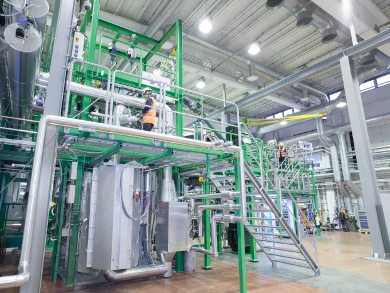Chemical-Looping Combustion (CLC) is a technological process using a circulating fluidized bed process. It involves oxidation of fuels where the oxygen is provided with solid oxygen carrier particles rather than with air. The reduced metal is then transferred to a second bed (air reactor) and re-oxidized. It then is reintroduced back to the fuel reactor. Using oxygen without nitrogen and the trace gases found in air, leads to a flue gas composed primarily of carbon dioxide and water vapor. Unlike in alternative technologies, carbon dioxide is easy to separate and capture. For this reason, CLC is expected to have at least 50 % lower energy penalty and cost than any other CO2 capture technology. Biomass burning with the CLC technology (Bio-CLC) is a new research area. Methods using oxygen carriers have not been commercialised so far.
The first experiments of VTT at a pilot testing at Bioruukki, Finland, proved the functionality of Bio-CLC as a biomass burning method. The team used untreated and heat-treated wood pellets as fuel and ilmenite as bed material for carrying the oxygen into the reactor. Ilmenite is a natural material mainly containing titanium-iron oxide. In the pilot, the thermal input reached 20 kW. This input level is 100 times higher than that achieved on a laboratory scale and approximately 1,000 times lower than the production rate of an industrial power plant boiler.
When using traditional combustion technologies, chlorine compounds in biomass cause an elevated high-temperature corrosion risk on heat-exchange surfaces. Therefore, the steam temperature must be kept low. This reduces the efficiency of the power production. Bio-CLC technology allows the use of high temperatures and the achievement of a high efficiency rate without any signs of a risk of corrosion, so far.
VTT carried out the combustion testing in the Carbon Capture and Storage Program (CCSP) coordinated by CLIC Innovation Oy, and financed by Tekes, Fortum Corporation, Helen Ltd and Amec Foster Wheeler Energia Oy. The Negative CO2 project, financed by Nordic Energy Research, acted as project partner. Further development of the method, combustion trials, and commercialization will proceed in the joint Nordic spearhead project Nordic Energy Research, in which VTT is involved.
- VTT Technical Research Centre of Finland Ltd., Espoo, Finland




